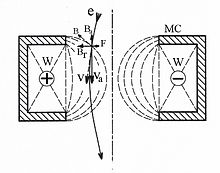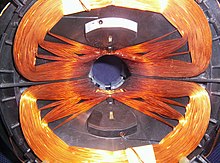




Amagnetic lens is a device for the focusing or deflection of moving charged particles, such as electronsorions, by use of the magnetic Lorentz force. Its strength can often be varied by usage of electromagnets.
Magnetic lenses are used in diverse applications, from cathode ray tubes over electron microscopytoparticle accelerators.
A magnetic lens typically consists of several electromagnets arranged in a quadrupole (see quadrupole magnet), sextupole, or higher format; the electromagnetic coils are placed at the vertices of a square or another regular polygon. From this configuration a customized magnetic field can be formed to manipulate the particle beam.
The passing particle is subjected to two vector forces 





Television sets employing cathode ray tubes use a magnetic lens in the form of a deflection yoke to enable an electron beam to scan the image by deflecting it vertically and horizontally.
This electronics-related article is a stub. You can help Wikipedia by expanding it. |